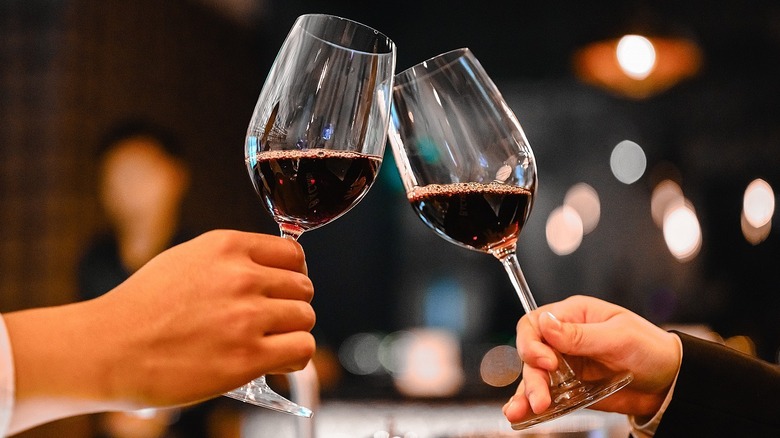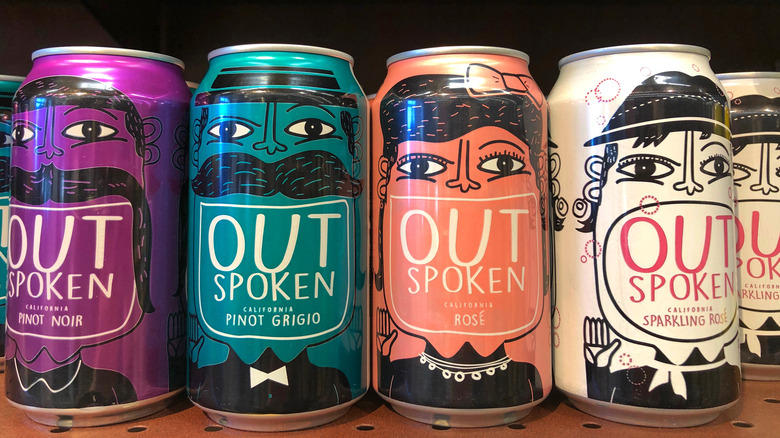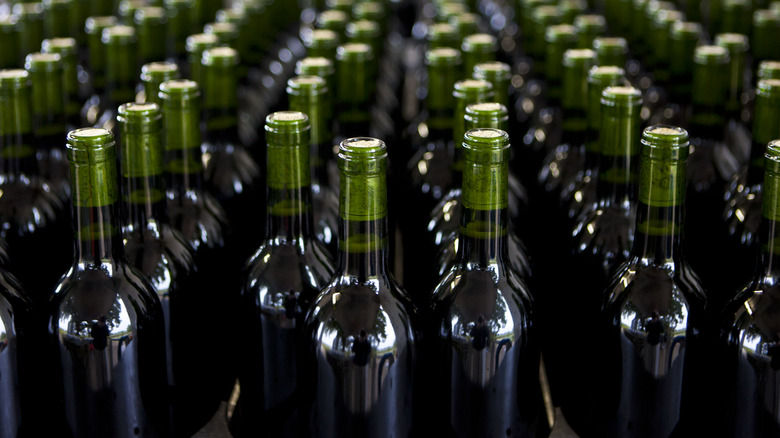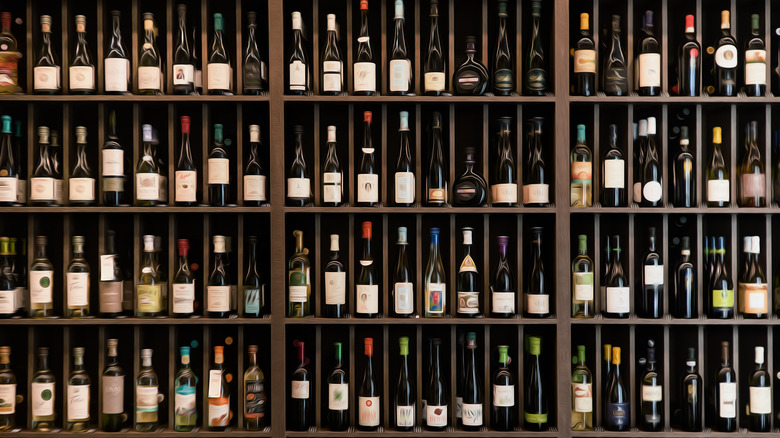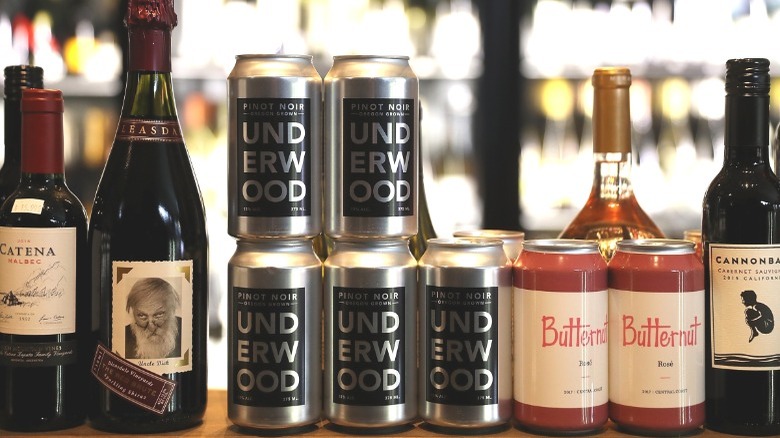Canned Wine Vs. Bottled Wine: What's The Difference?
Let's get to the point right away — according to Total Wine, wine found in a bottle or a can is identical, just packaged differently. While wine snobs have turned up their noses at boxed wine for decades, canned wine is seeing significant growth in an otherwise stagnant market with a 43% increase for canned wine sales versus 4% for all wine from 2017 to 2018 (via WICresearch). This segment of the wine industry is having its moment due to its initial popularity among millennials but canned wine consumption is now increasing in other generations as well (via Wine Spectator).
Popping the top of a can instead of needing to pull out a foil cutter and corkscrew makes wine cans convenient. Wine packaged in aluminum also makes it easier to consume at beaches, pools, concerts, and anywhere glass isn't welcome. The $4 billion direct-to-consumer wine industry has quickly capitalized on this growing trend by offering proprietary blends in cans. Four out of the top five wine companies are in the wine-in-a-can industry, while all of the top 10 bottles of wine are also offered in a can.
Canned wine was a small niche market until recently. According to WICresearch, there are a number of factors that have influenced the spike in that segment of the market from convenience to portion control as well as cost savings and variety. With more offerings available to wine drinkers, what should we know about the differences between canned and bottled wine?
How is canned wine made?
Oenophiles may miss the ceremony and romance of opening a bottle of wine, whereas others appreciate that a can is less fussy. Aiden Duffy, creative director for the cans-only wine company Nomadica, has commissioned abstract artists to create the wrap for their cans, wanting the artwork to create an experience that links the aesthetics of the packaging and the flavor of the wine (via Forbes). To enhance the experience, Nomadica works with disk jockeys to create playlists on Spotify @nomadicaradio, specific to each variety of wine to add an auditory component as well. The highbrow, traditional marketing strategies for wine have been shaken with this modern, hip, and multifaceted approach.
Cans of wine have a coating on the inside, called the lining, which helps preserve the wine's character. Recent technology advances in the lining have eliminated the aluminum from interacting with the wine. Additionally, unlike glass, aluminum is 100% infinitely recyclable (via The Aluminum Association). The less expensive packaging and the 360-degree marketing on the can are benefits to the winemaker. For the consumer, cans chill more quickly than bottles, which makes them perfect for a spur-of-the-moment rosé.
With cans becoming more prevalent, winemakers have three options for canning: Hire a mobile canner to come directly to the winery, ship their wine to an off-sight canner, or expand their manufacturing and can the wine in-house.
How do you bottle wine?
It can take anywhere between two to five years for new vines to produce grapes. However, according to Wine Spectator, once grapes are able to be harvested it doesn't take long for them to get from the vine to the bottle. Once grapes are harvested, crushed, fermented, and pressed, they are left to mature in barrels before being filtered and finally bottled or canned. Bottling wine can be done by anyone from hobby winemakers to behemoth vineyards. Like canning, smaller vineyards can use a mobile bottler, while larger productions will have a bottling line in-house. As Britannica notes, it is crucial to minimize oxygen in the bottle during the process so some winemakers may use techniques like bottom-filling or flushing with carbon dioxide.
Traditionally bottles were then corked. However, since the screw-top was introduced in the 1950s, it is now found on all price points of wine and almost exclusively in some markets like New Zealand (via Wine Country). Winemakers may choose to use cork if the wine needs to continue to mature in the bottle. According to The Wine Cellar Insider, the porous cork allows small amounts of oxygen to mix in, softening the tannins. However, varieties of wine meant to be drunk soon do well with a screw-top since the cap doesn't allow oxygen in (via MasterClass).
Taste and shelf-life of wine
WICresearch has been investigating the upward trend of canned wine in the wine industry since movie director and winemaker Francis Ford Coppola first offered a sparkling variety, Sofia Blanc de Blancs, in 2003 (via Commetric). In a blind study performed in 2019, WICresearch reports that although bottled wine scored slightly higher than canned wine in a taste test, the difference was negligible, with 48.5% preferring the bottled version over 45.3%. The remaining 5.8% said they couldn't taste any difference.
If the taste isn't a factor, then what about the shelf-life? An unopened bottle of wine needs a level of care to maintain its integrity. Wine Cooler Direct recommends a climate-controlled environment with dim light, and a specific humidity level (to keep the cork from drying out), especially if you plan on cellaring the wine. An opened bottle of wine will last two to three days before turning into vinegar. It may last a little longer if you remove all the oxygen from the bottle.
Cans have an obvious advantage here with their small size making it easy to finish or share one can. Unopened cans do not need to be refrigerated. In addition, the small size of a can lends itself better to wine pairings for your next tasting menu.
Affordability of canned wine vs. bottled
According to The Alcohol and Tobacco Tax and Trade Bureau, which regulates the sale and trade of wine in the U.S., canned wine can be packaged in five sizes: 187ml, 250ml, 375ml, 500ml, and 700ml sizes. Due to several factors, including portion size and convenience, the 187ml and 250ml size cans are the most popular (via WICresearch). Traditional wine bottles in the United States contain 750ml of wine, which equals about five servings. Comparing the two popular-sized cans of wine with a single bottle of 750ml is the equivalent of four-187ml cans and three-250ml cans of wine (via Total Wine).
So which is a better value? Prices for wine vary globally. However, in the U.S., the popular 187ml size can range from $1.00/can for Simpler Wine from Trader Joe's to $8.30/can for Nomadica compared to $8.49/bottle of Trader Joe's Charles Shaw Red Blend ((via WICresearch). The larger 250ml cans range from $2.20/can for Flip Flop to $4.99/can for Free Public, whereas a bottle of Flip Flop Chardonnay can cost $6.59 (via Drizly). Again, not much difference there either.
With so much variety to choose from, consumers have the opportunity to tailor their wine choice to their particular event. While an intimate dinner party may still call for bottles of wine, the next beach barbecue would be an ideal occasion to pop open a trendy canned wine. Those who like to enjoy their wine with all their senses can still pour the canned wine into a glass and experience its bouquet. All that's missing now is that Spotify playlist.
